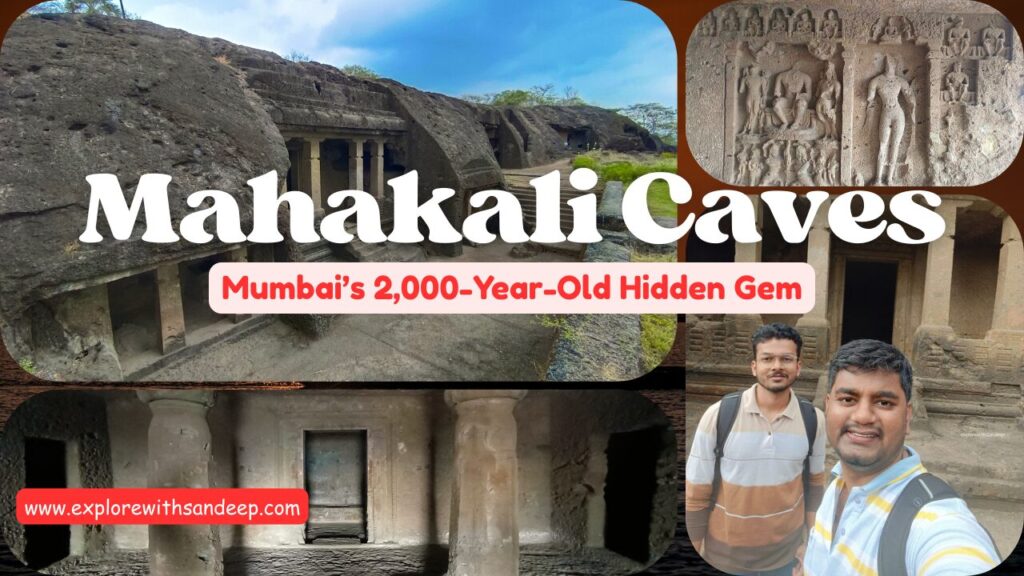Mahakali Caves, Mumbai
Namaste dosto!
People find happiness in all sorts of things – some love watching movies, some love eating delicious food (who doesn’t?), and some, like me, find joy in exploring places they’ve never been before.
So, if you asked me, “Sandeep, what makes you happy?” I’d proudly say: exploring hidden gems.
Today, I’m taking you along on my journey to one such hidden gem in Mumbai – Mahakali Caves, a 2000-year-old site located in Andheri. Sit back, relax, and join me on this fun and fascinating trip into Mumbai’s ancient past.
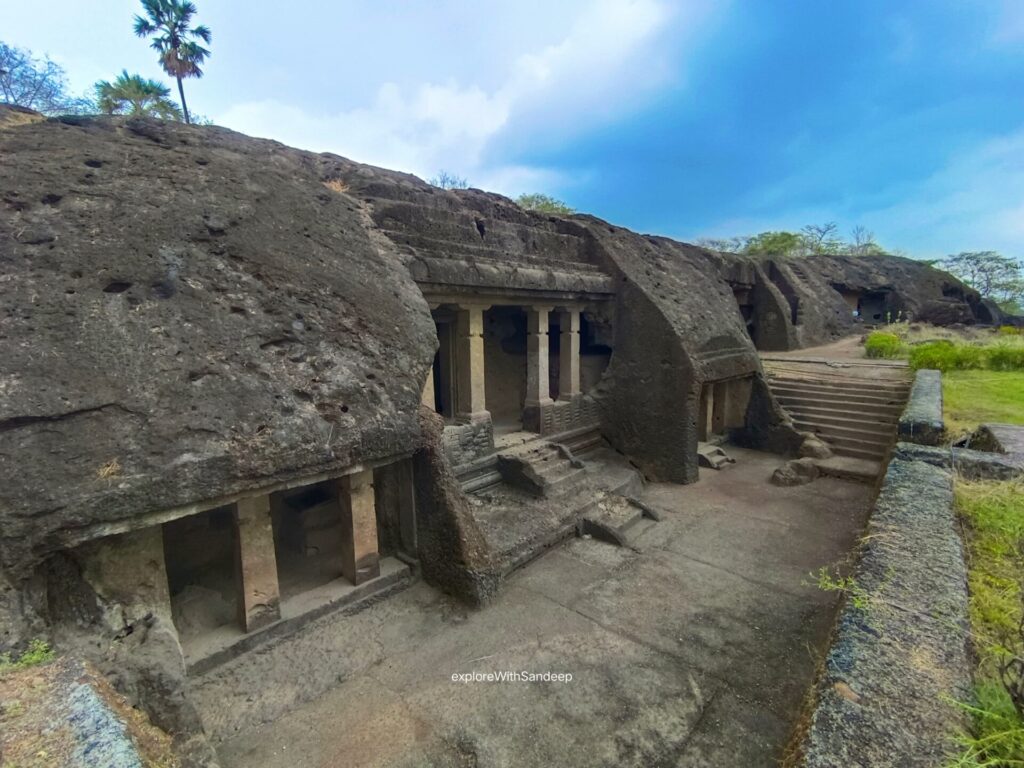
Mahakali Caves History

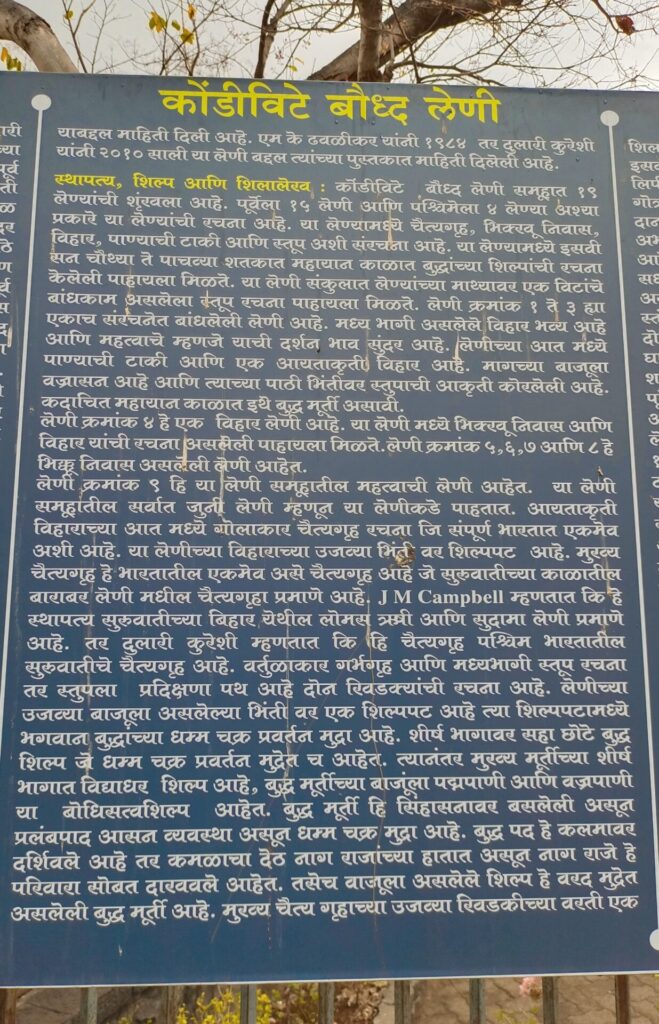

The Mahakali Caves are very old caves in Mumbai, carved more than 2000 years ago. Long ago, Buddhist monks used these caves to live, pray, and meditate quietly. At that time, Mumbai was not a busy city like today; it was full of forests and small villages, making it a peaceful place for the monks. Even though many carvings on the walls have been damaged over time, the caves still tell the story of Mumbai’s ancient past. Visiting Mahakali Caves today feels like stepping back in time and seeing how people lived and prayed so many years ago.
How the Journey Began
I was randomly scrolling through Google, searching for new places to explore, when I discovered Mahakali Caves – just 3 km away from my office! I thought, “Why not visit this marvel tomorrow morning?”
So, the next day, I woke up early (which is a miracle in itself, trust me!) and started my journey at 8 am. The weather was perfect – cool, cloudy, and drizzling lightly at Khar Road. Honestly, it was one of those rare Mumbai days when you don’t feel like you’re inside an oven all day😂.
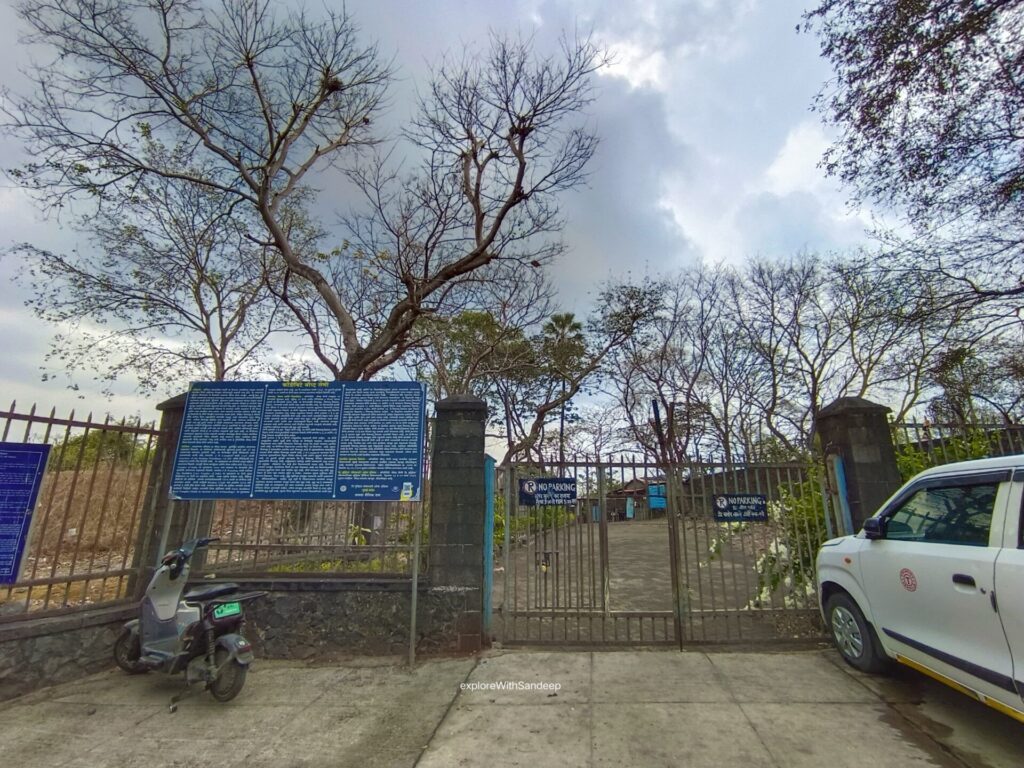

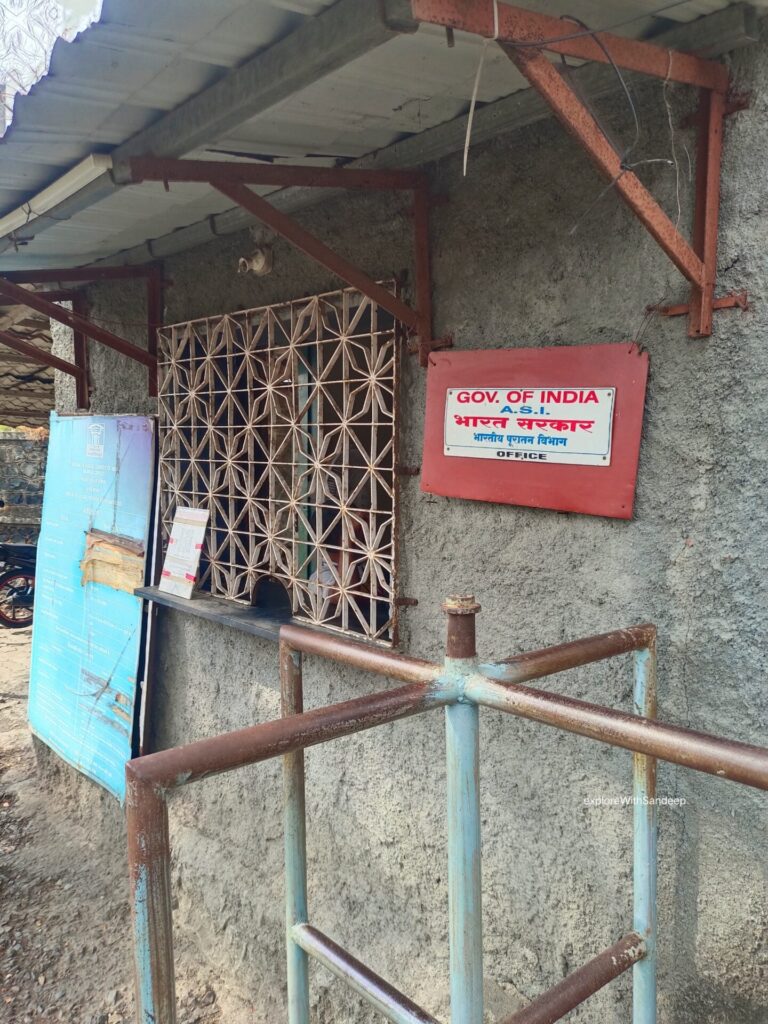
After a 45-minute bike ride, my friend Shreyas and I reached the destination. Note: there’s no official parking here, so we had to find a small spot nearby to park the bike.
Here comes the Digital India twist – at the entrance, they don’t accept cash! You need to scan a QR code, fill out a form online, and download a virtual ticket. Fancy, right? But hey, small things like this make you feel India is really moving ahead!
Exploring Mahakali Caves
From the outside, it looks like just a big rock surrounded by residential buildings 🏢. But once you step inside — magic ✨. The caves are actually carved below ground level, surrounded by trees 🌳, and have well-maintained walkways (though some repair work is still ongoing 🔨).
The Mahakali Caves are a group of 19 rock-cut caves, also known as the Kondivite Caves (named after the nearby Kondivti village). While the name “Mahakali” comes from a nearby Hindu temple dedicated to Goddess Kali 🕉️, the caves themselves are Buddhist in origin and date back to the 1st to 6th century CE ⏳.
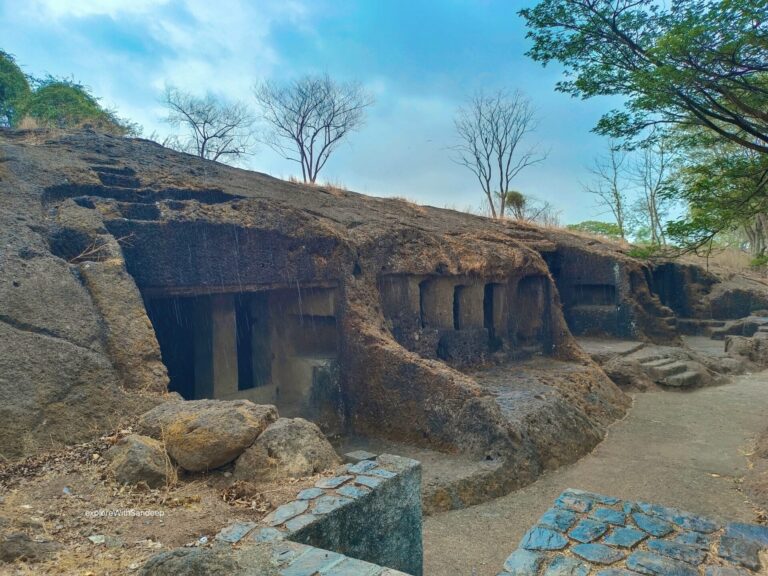
Imagine that — ancient monks, over 2,000 years ago, carved these caves by hand using chisels, hammers, and endless patience 🛠️. And here I was, struggling to draw a straight line back in engineering college even with a fancy drafter!😂
South-East Group: Caves 1–15
Cave 1, 2, 3 (Interconnected Caves with Courtyard):
The moment I stepped into Caves 1, 2, and 3, I realized they were interconnected, forming a larger complex. Among these, the middle cave stood out as the largest, and as I walked further in, I entered a courtyard supported by stone pillars. Many of these pillars had been worn down by centuries of wind and rain, yet they still held up the space with quiet dignity.

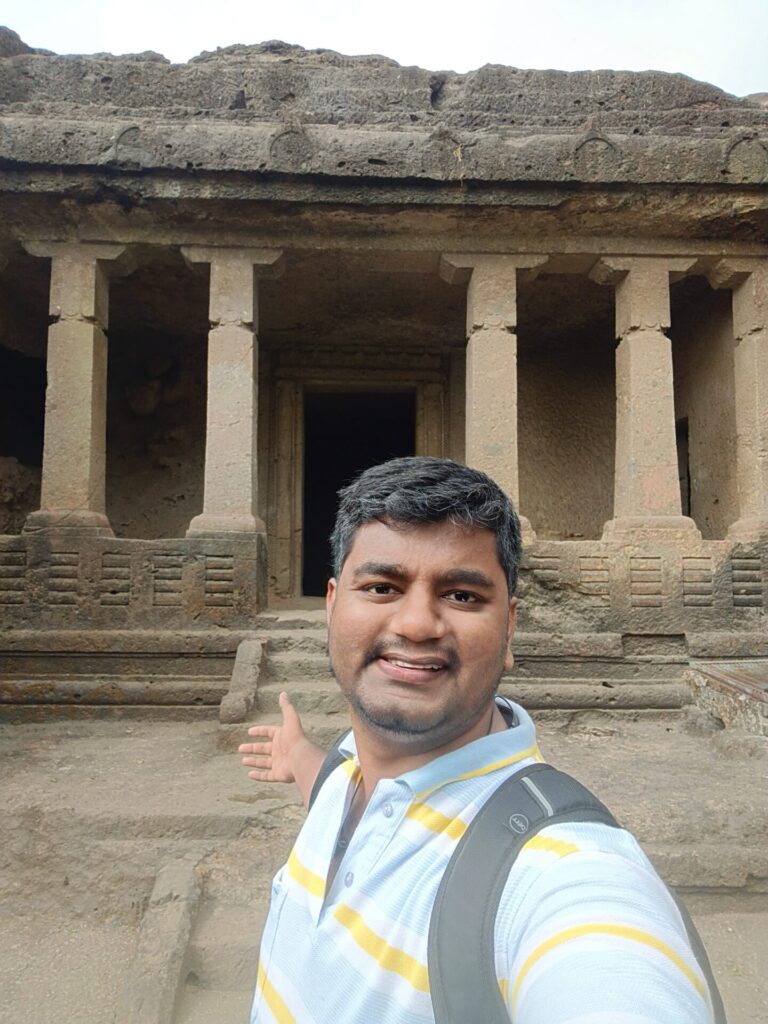
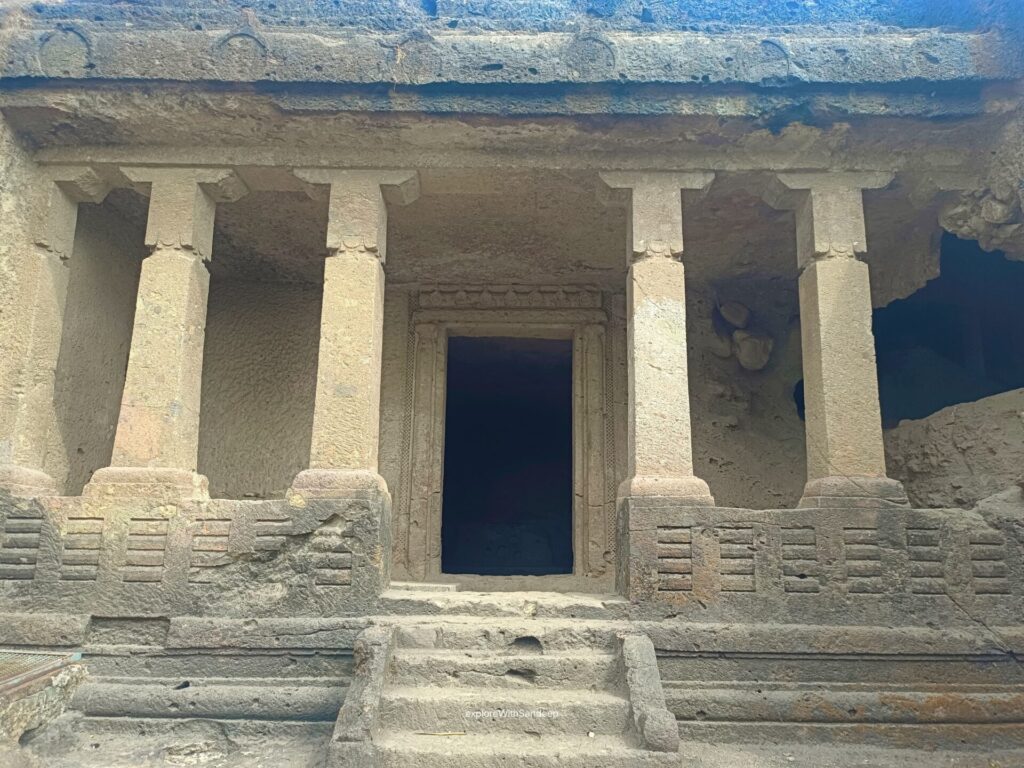
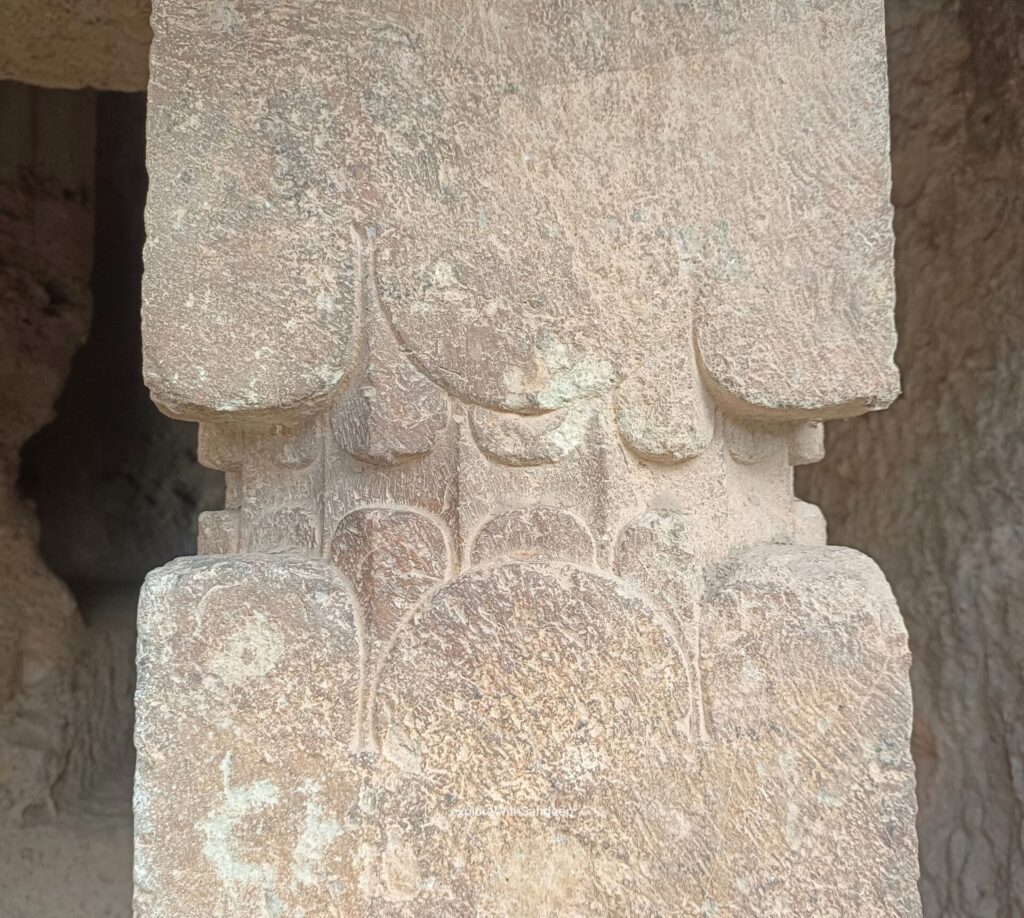
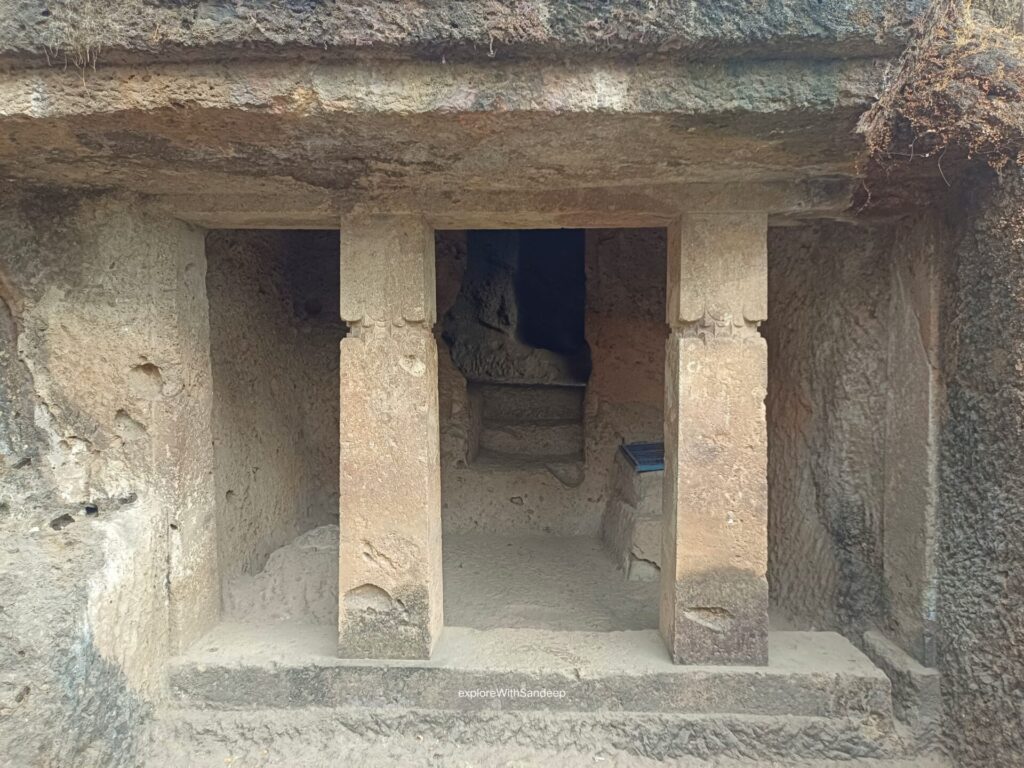
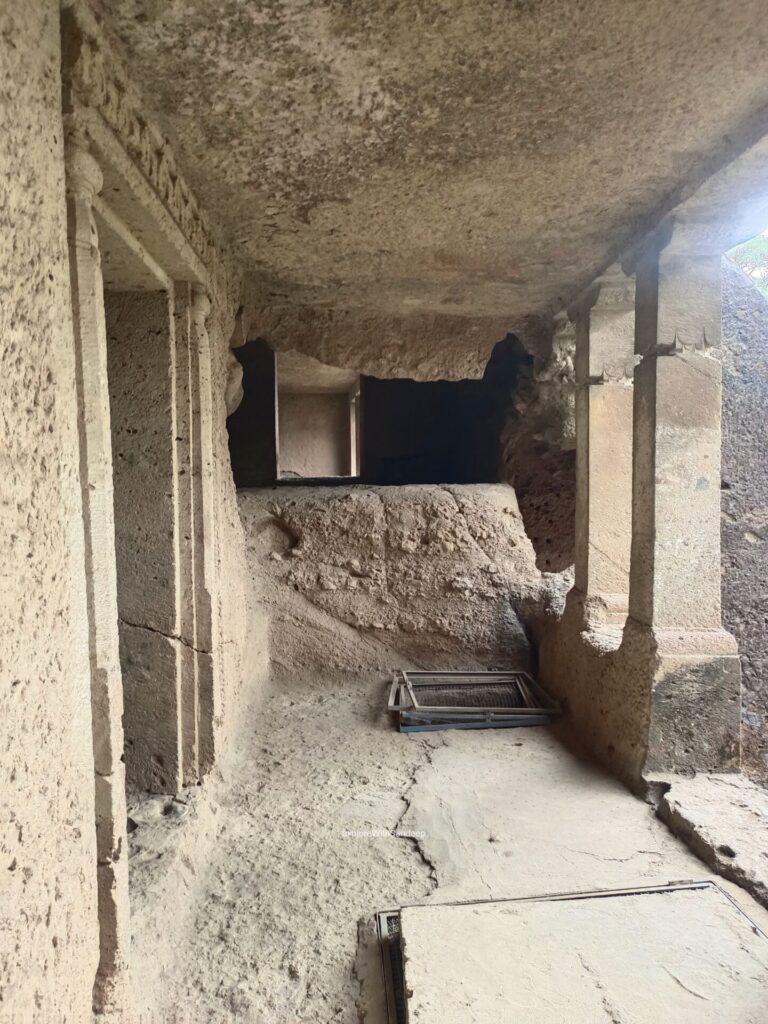
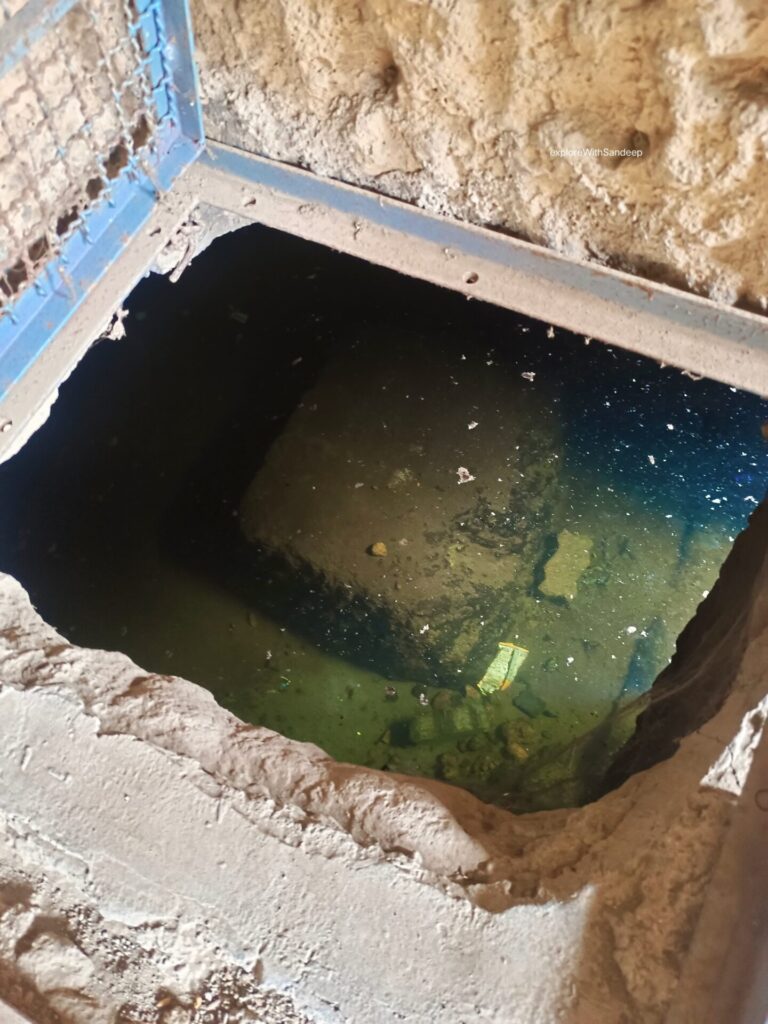
What really caught my attention was the underground water tank — a marvel of ancient engineering! I couldn’t help but wonder: how did engineers 2000 years ago design such detailed, functional spaces, when even during my own college engineering days, I’d struggle to draw a neat line using a drafter?

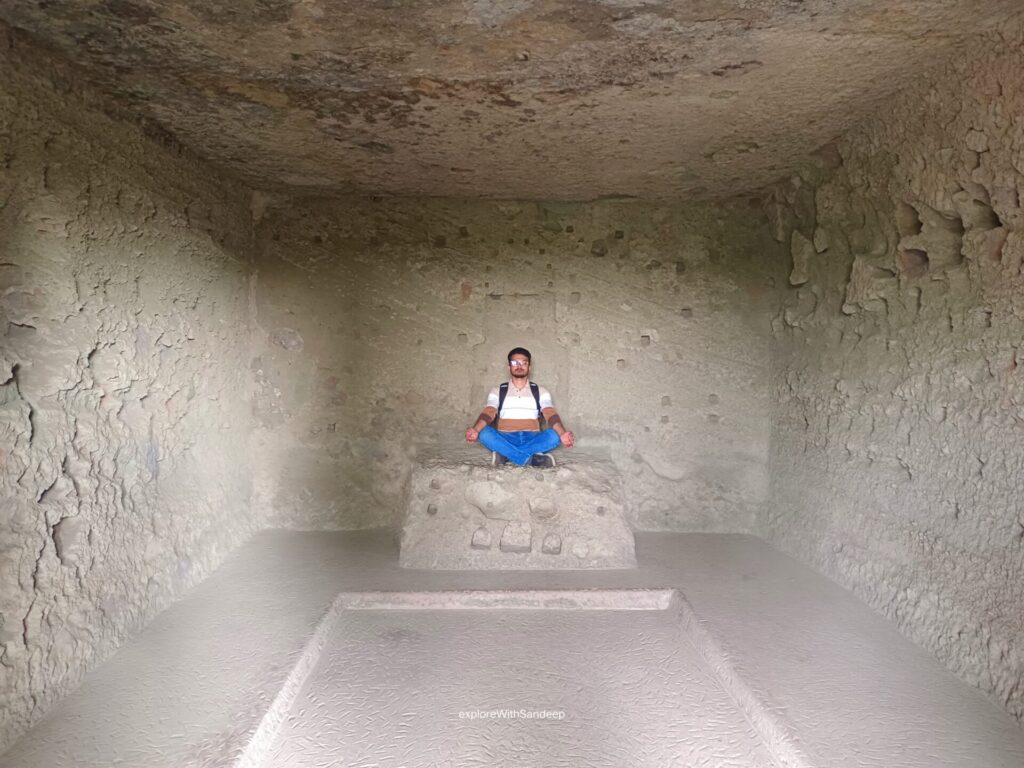
Inside the rectangular hall, there was a seat carved for a statue, probably once occupied by a Buddha figure or another revered idol. On the back wall, I saw a stupa, still standing tall, though weathered. My friend Shreyas, always ready for fun, immediately jumped into a meditation pose on the statue’s seat, while the rest of us laughed and clicked the must-have tourist photo! 📸
Cave 4 (Vihara Cave):
This was the first large cave I stepped into, and it had simple chambers on both sides.
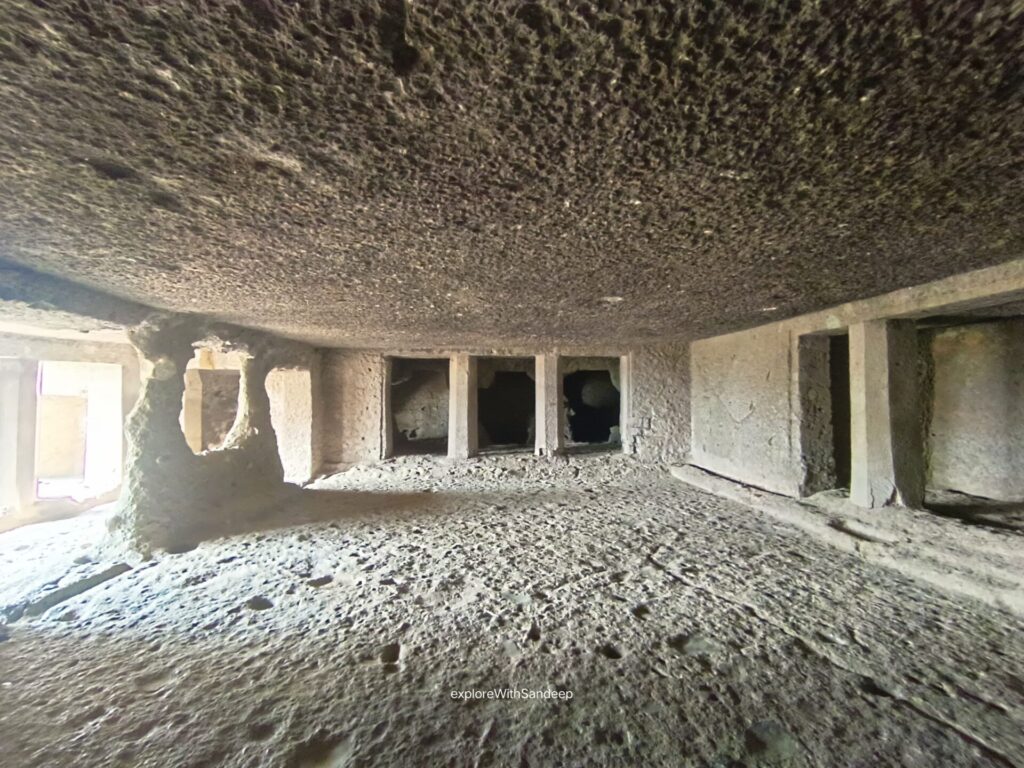

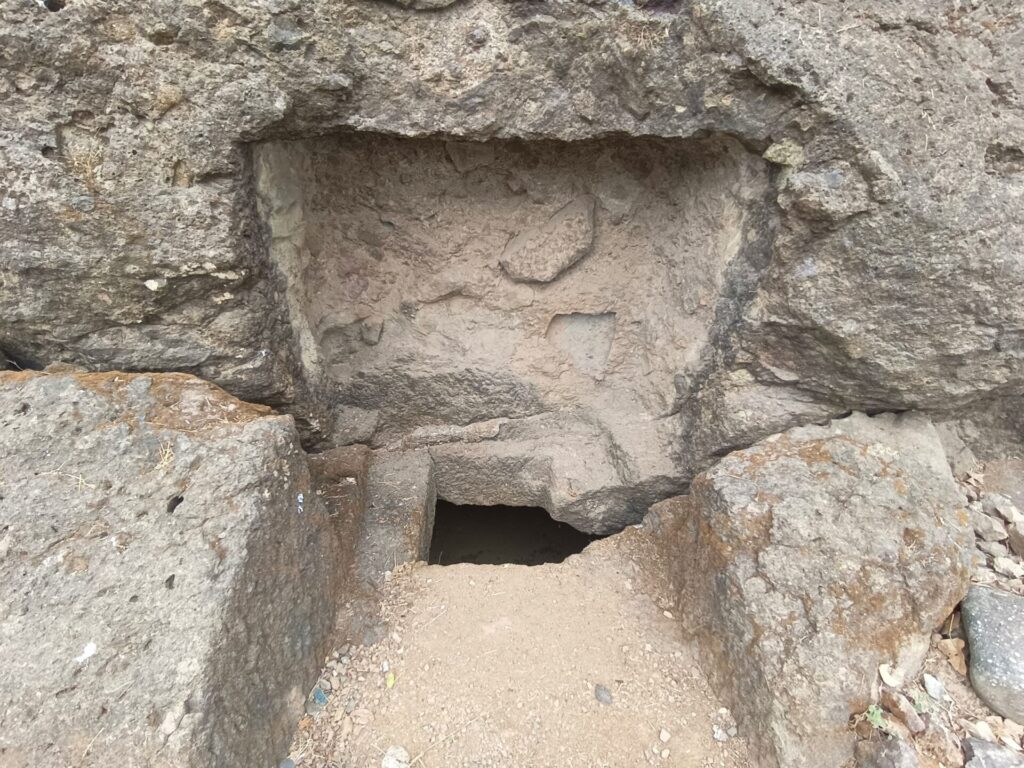


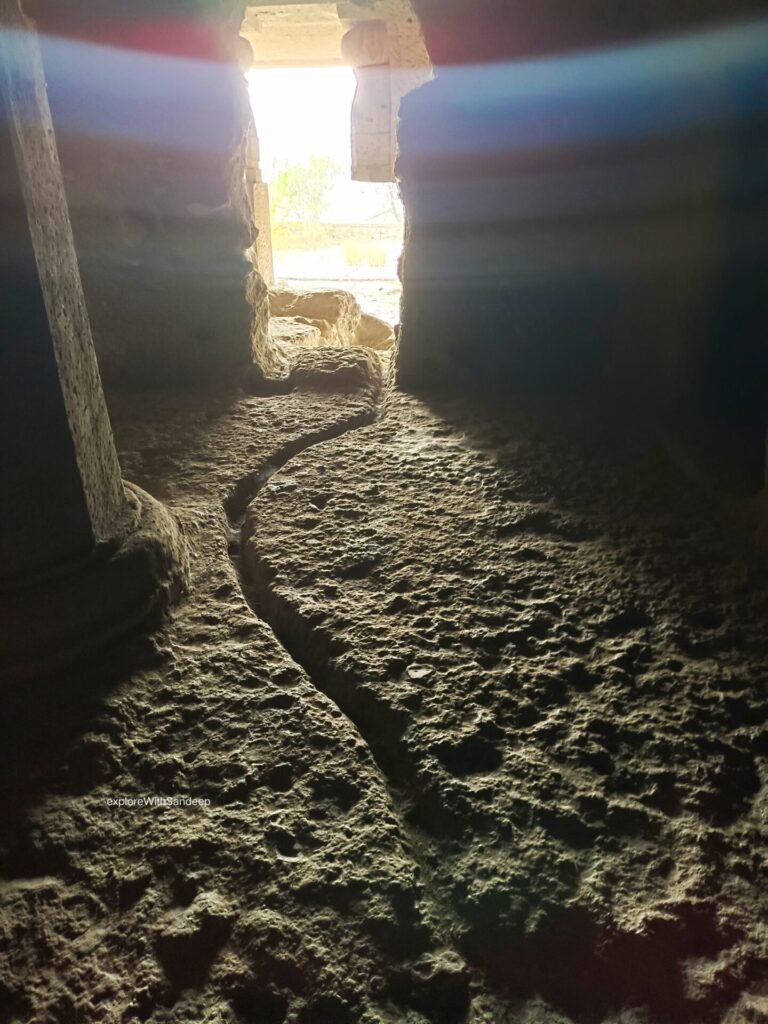
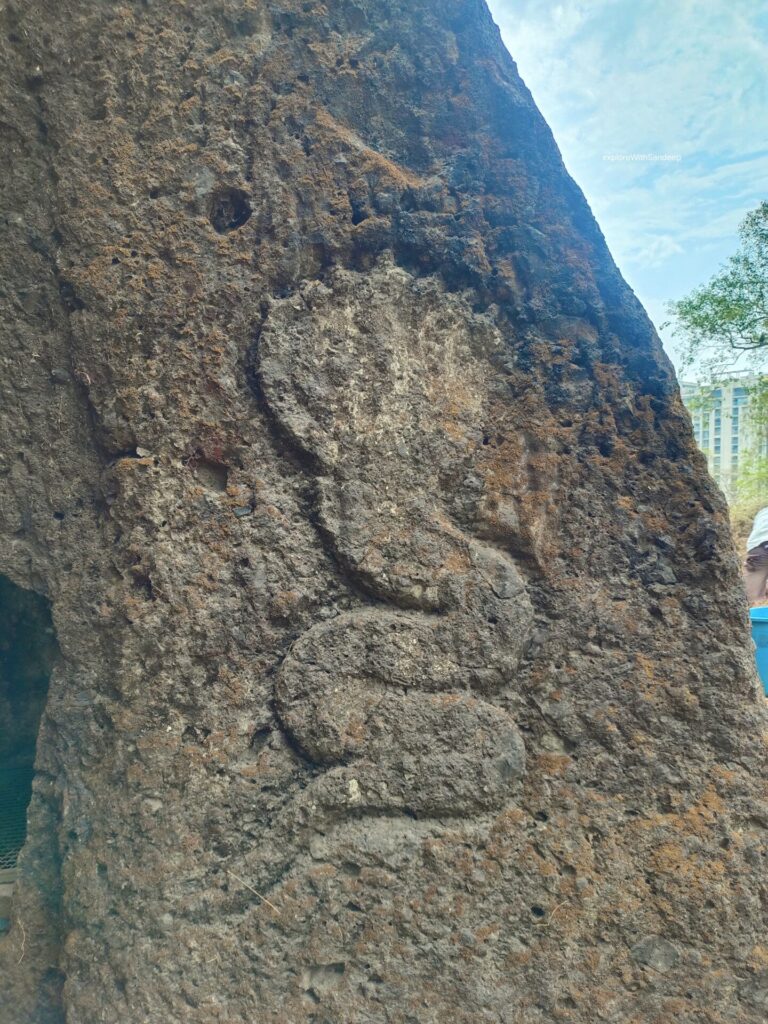
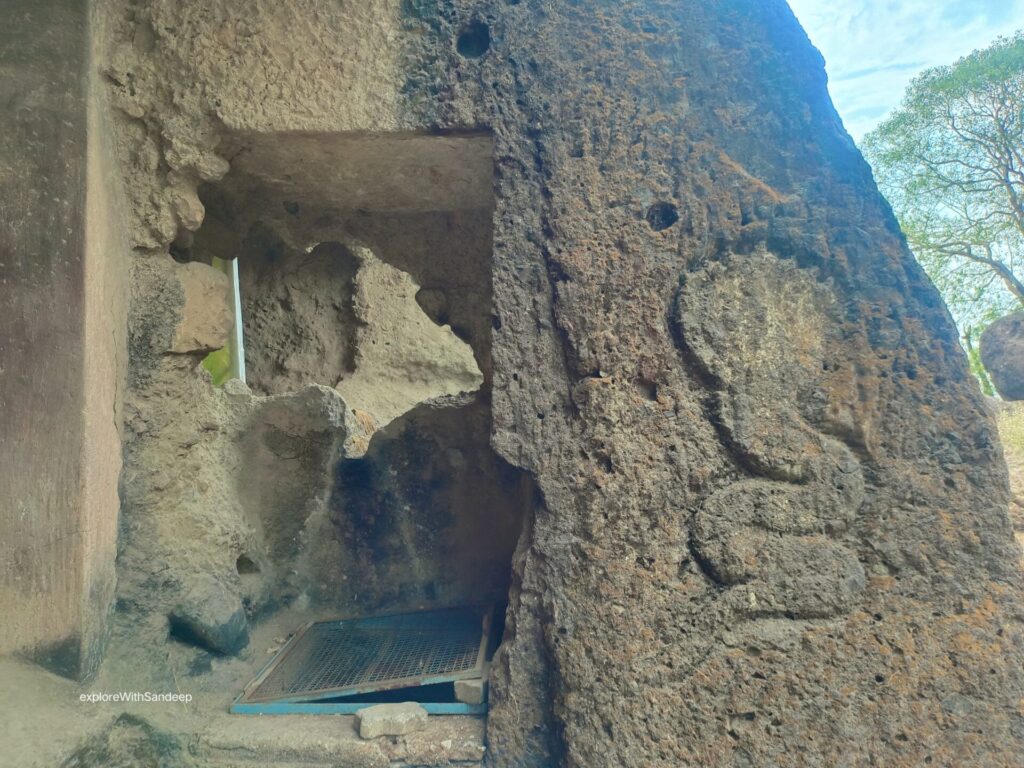
There wasn’t much intricate carving inside, but right outside, I noticed a rough seven-hooded cobra carving, which locals say is connected to the nearby Sarpala (snake pond). Standing there, I could imagine monks meditating here centuries ago, with the cobra symbol offering protection and spiritual significance. The coolness inside the cave and the soft echoes of my footsteps made it a peaceful, reflective space.
Caves 5, 6, 7, and 8 are part of this northern section. These caves may not look as grand from the outside, but they hold simple Buddhist cells (called viharas) where monks once lived and meditated. Though some parts are damaged or worn out over time, standing inside gives you a quiet glimpse into the lives of monks from centuries ago.
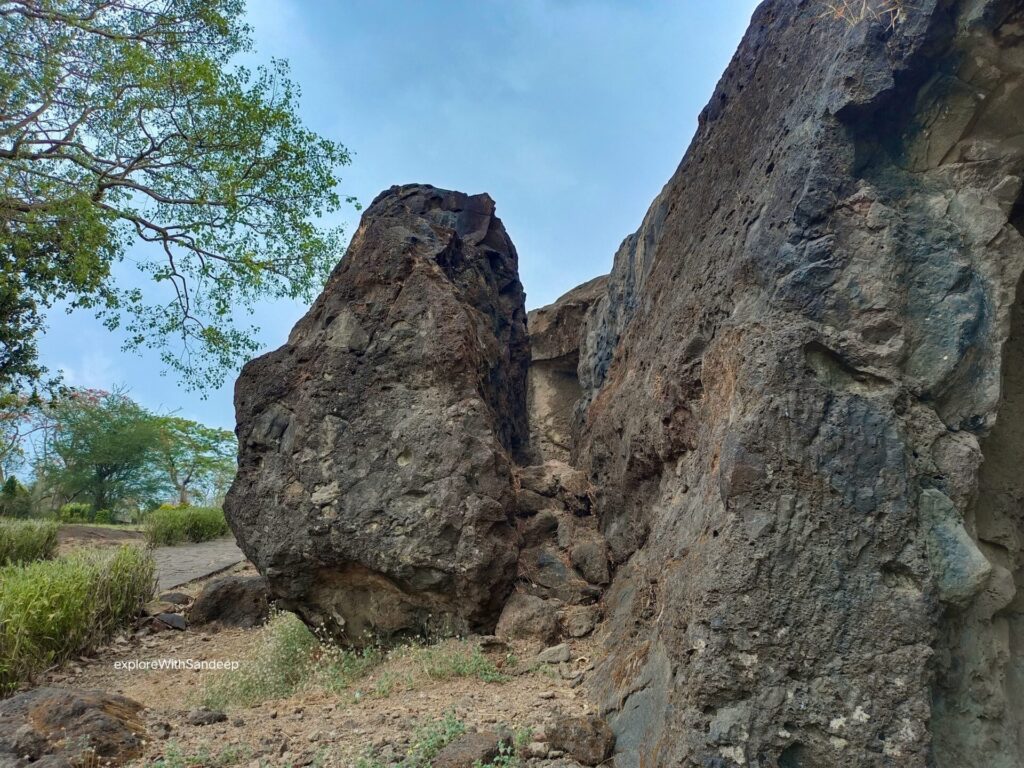
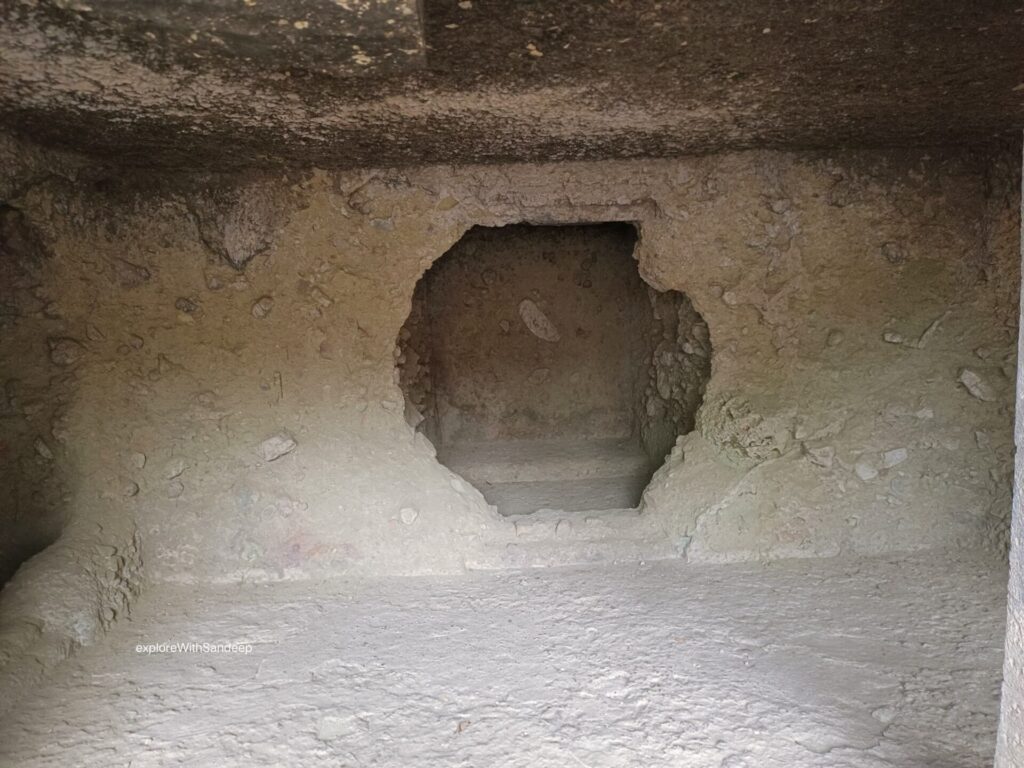
Cave 9 (Chaitya Cave):
This is the main cave and likely the oldest excavation at Mahakali. Locally, it’s called Anasicha Kamara (the granary), because its semi-circular shrine shape looks a bit like a storage hall.
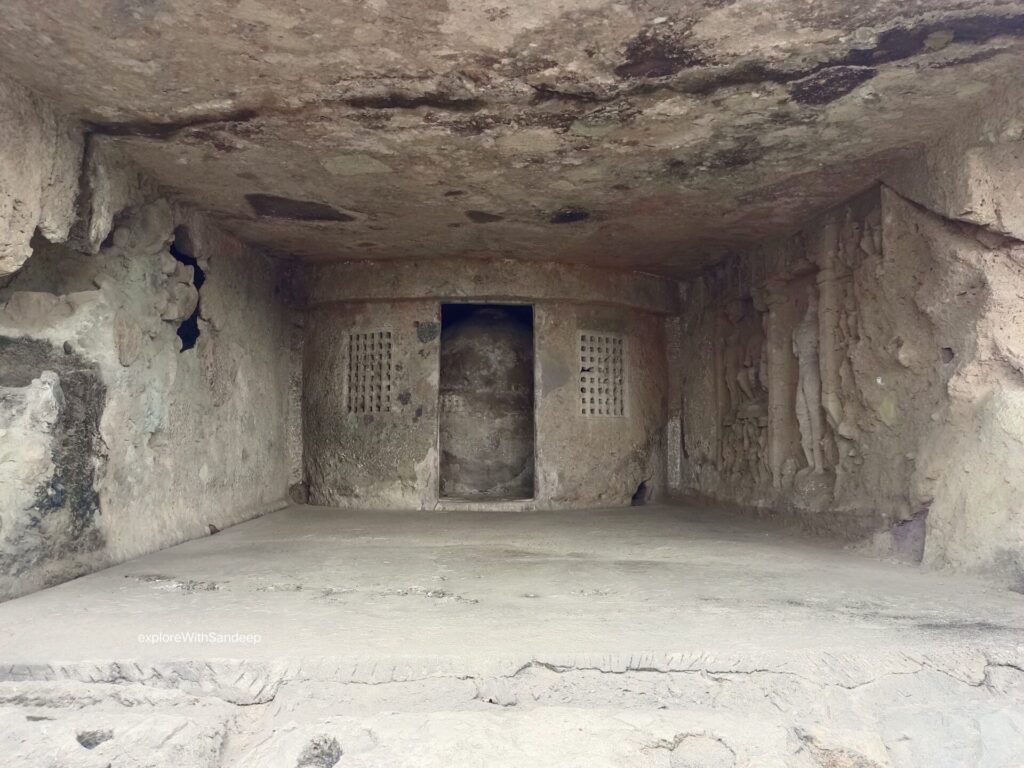
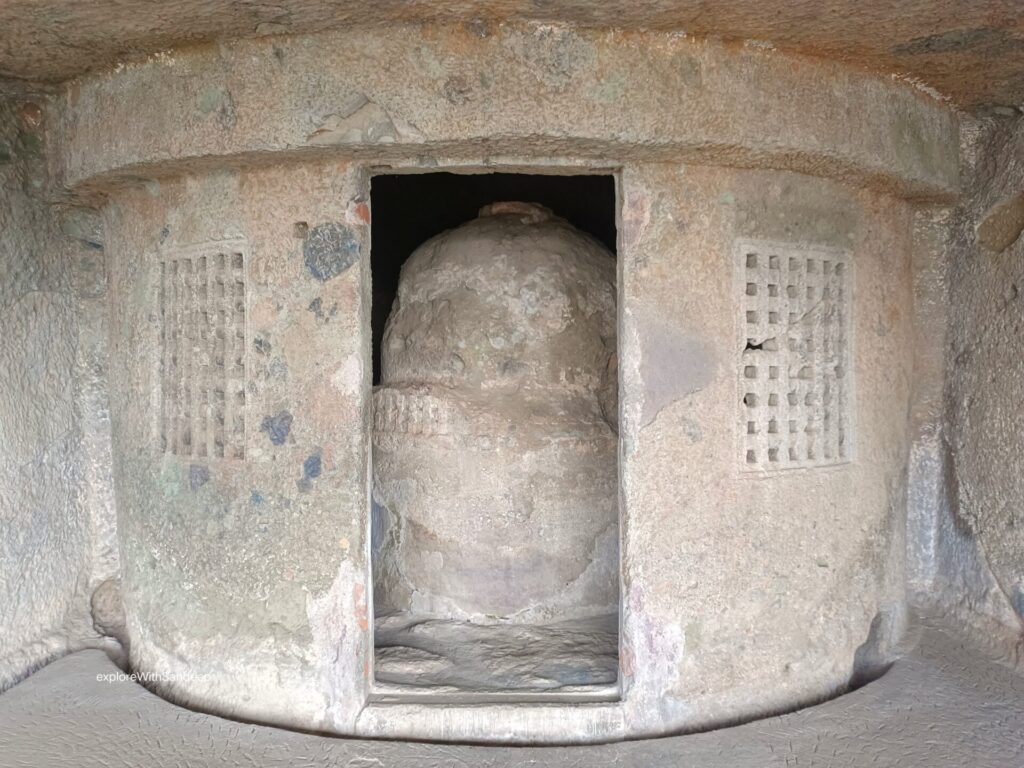
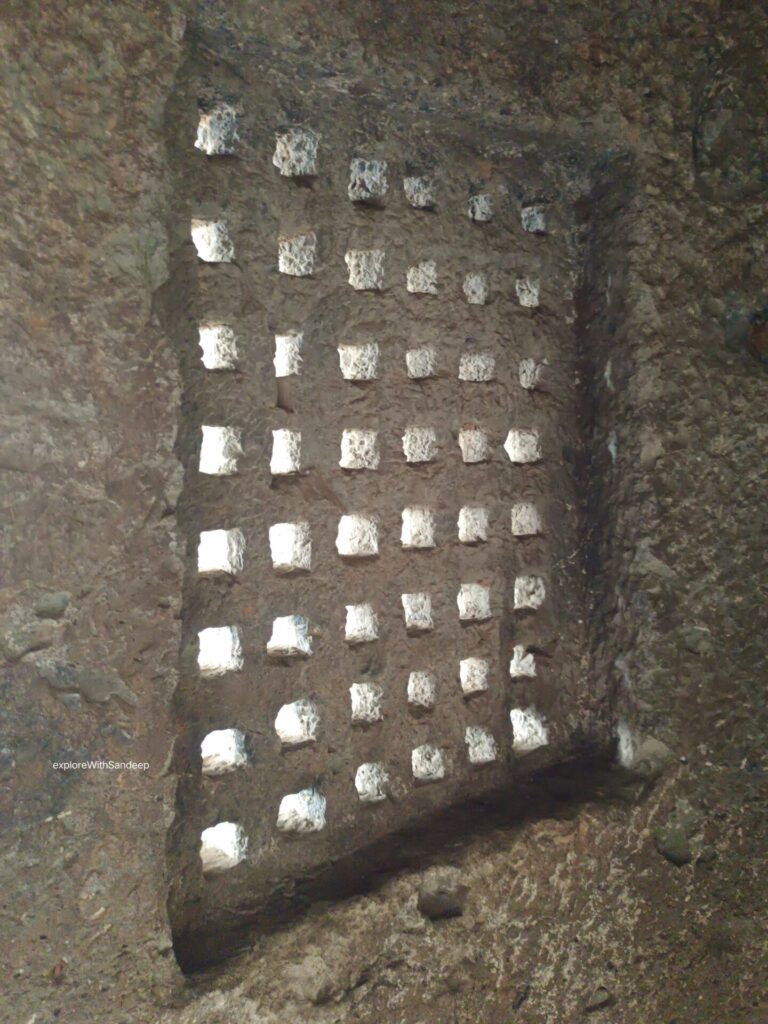
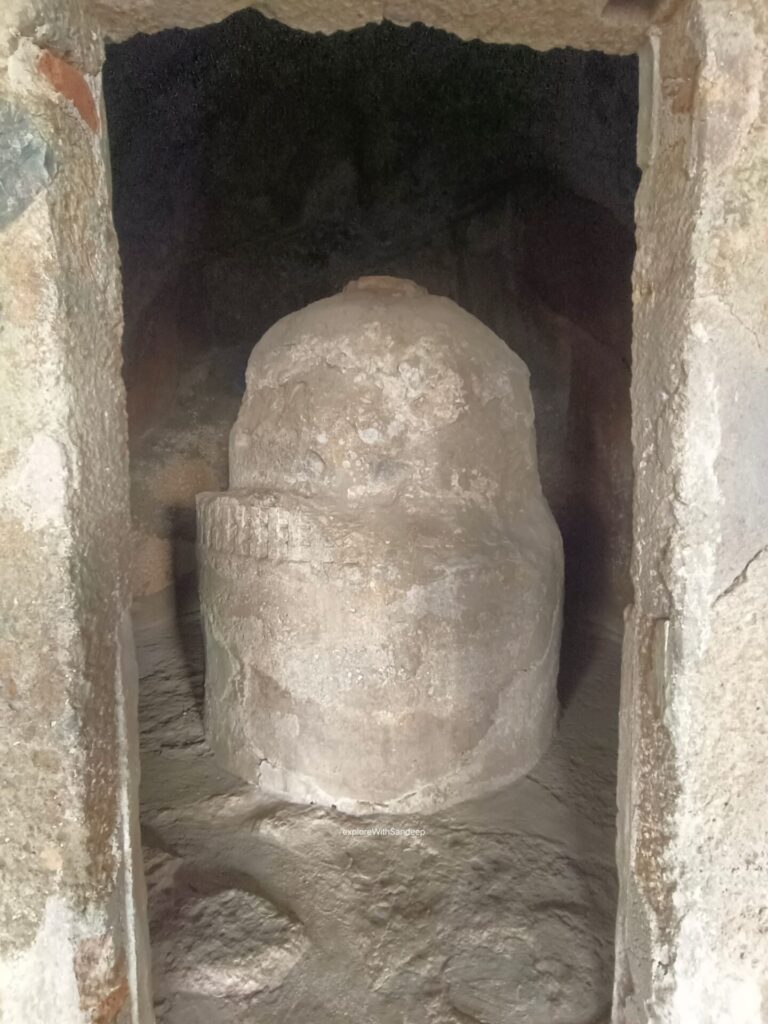
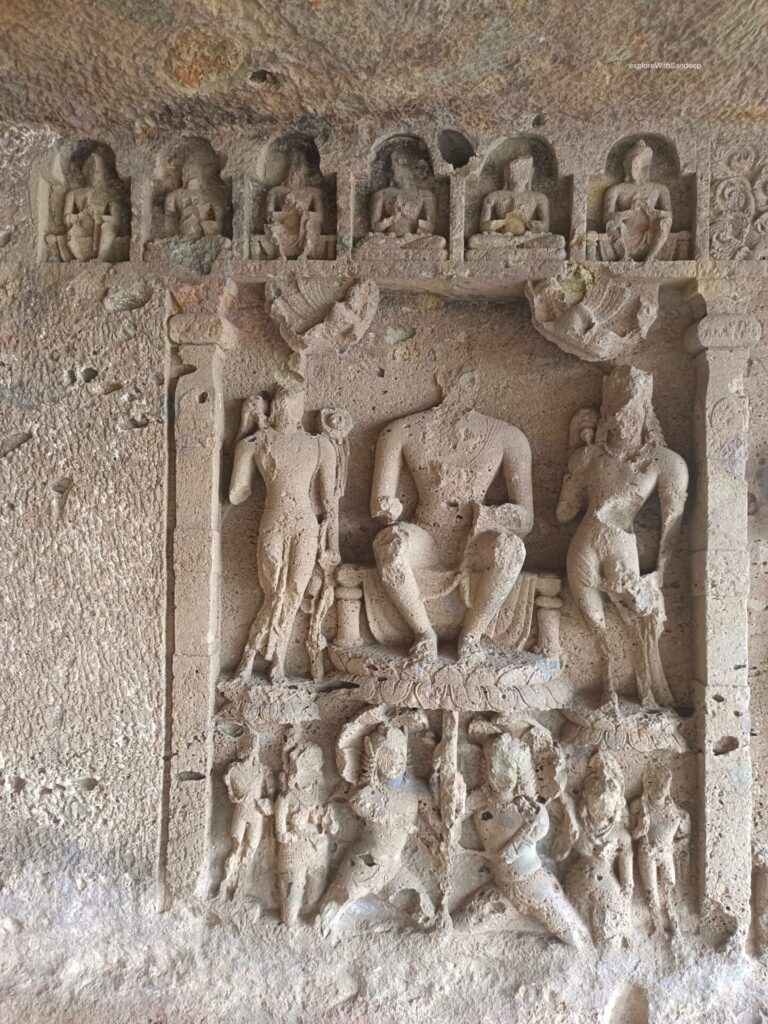

Caves 10–15 (Meditation Cells and Pillared Halls):
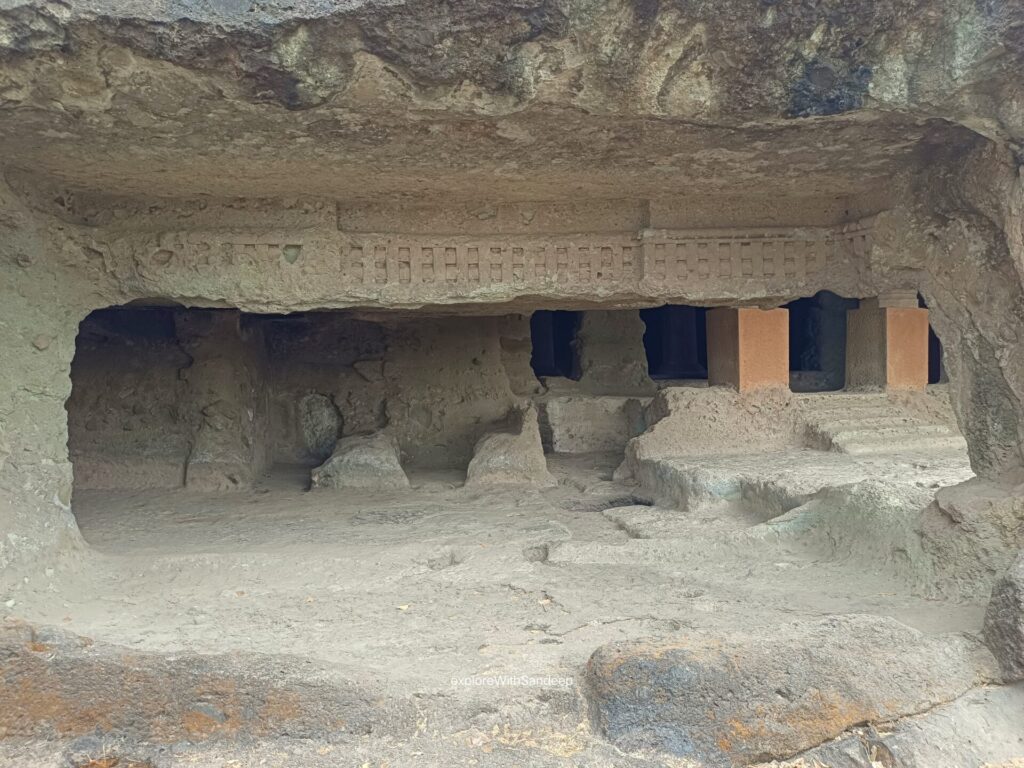



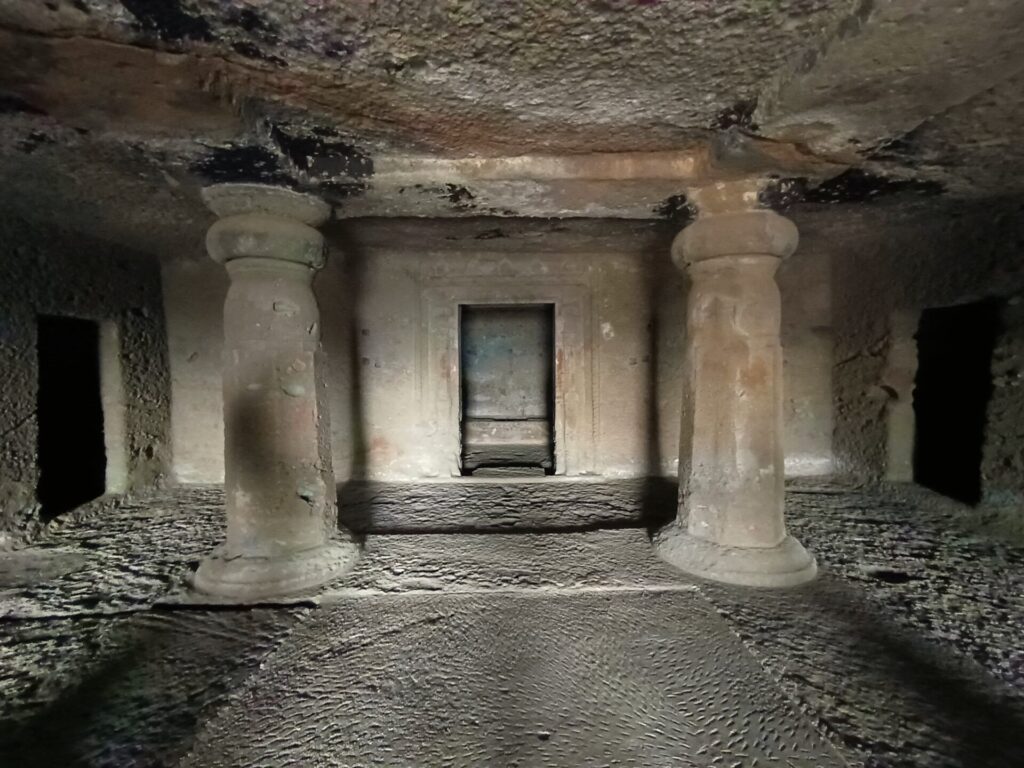

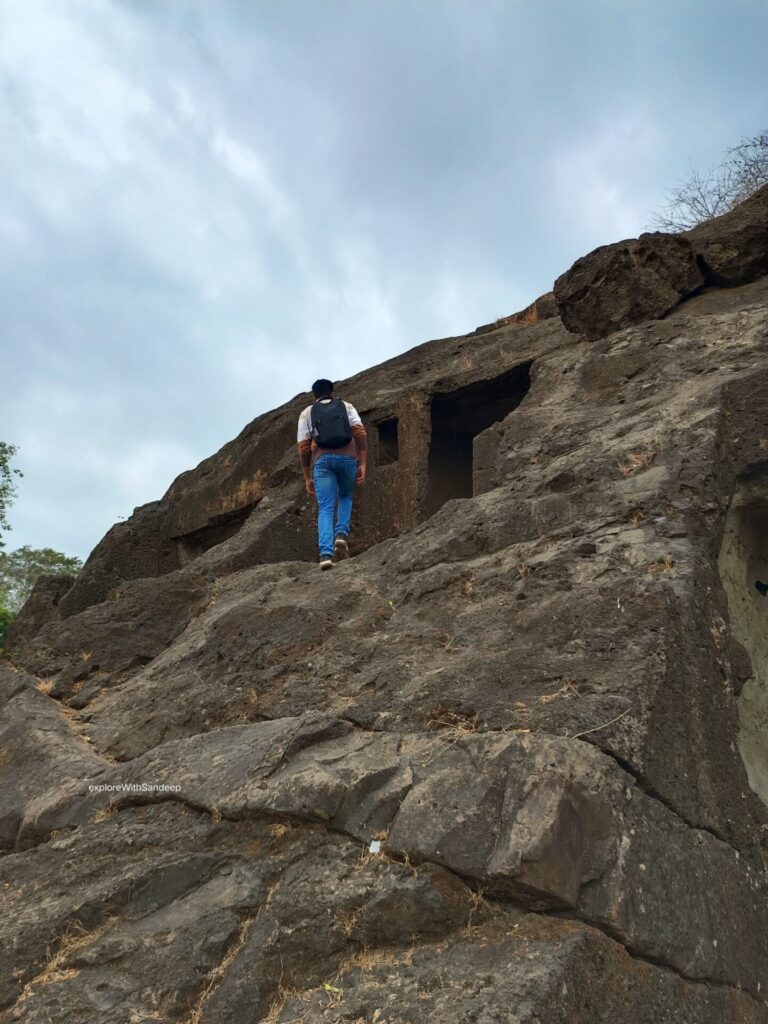

Walking into caves 10 to 15, I found a mix of small, simple meditation cells and larger halls with octagonal pillars. Some of these pillars had beautiful amalaka patterns on top, which reminded me of the spiky sun motifs used in Indian temple design.
Over a few lintels (door frames), I noticed old, delicate carvings — though weathered, they still held an artistic charm.
North-West Group: Caves 16–19
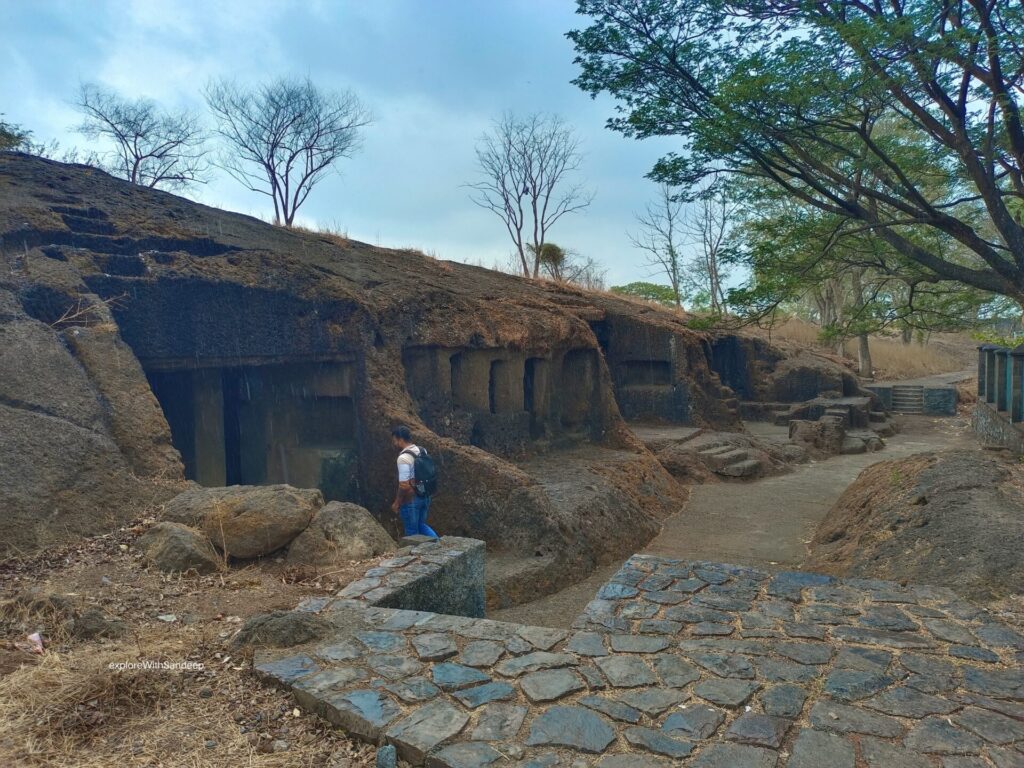
Cave 16
This cave is plain, with no decorations. It has a small verandah (porch), a main hall, a shrine (small temple space), and small rooms (cells) on both sides.
Cave 17 (Dining Hall Cave):
Inside Cave 17, I found long stone benches along the walls. Experts think this was once a monastic dining hall, where monks gathered for quiet meals.
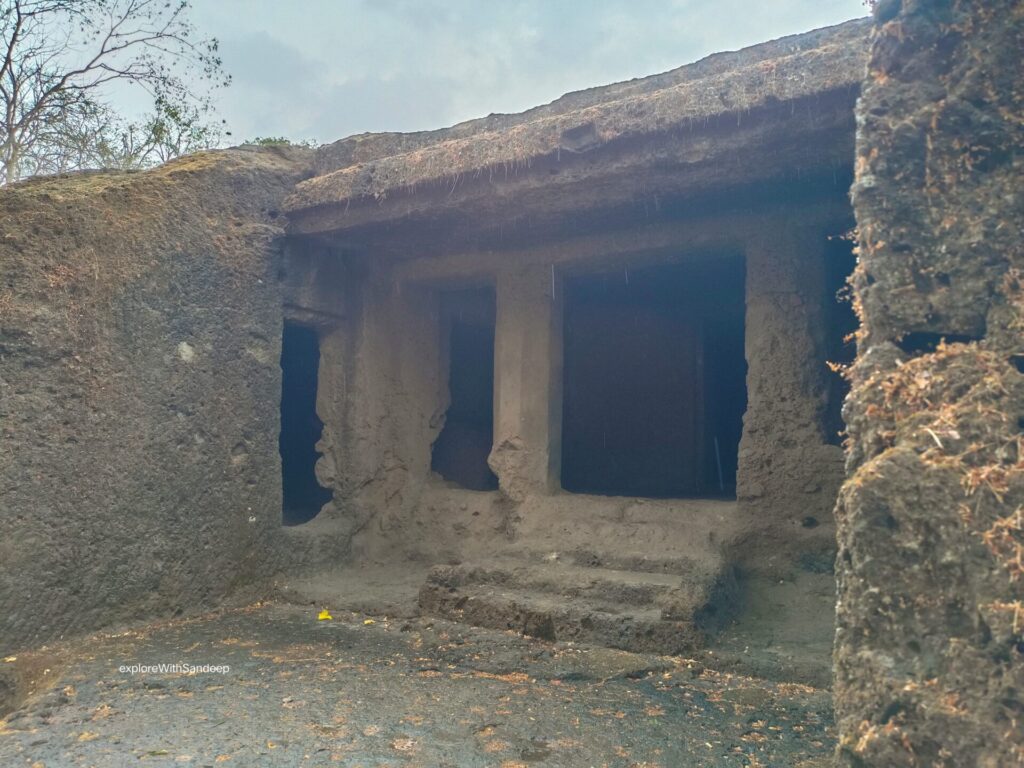
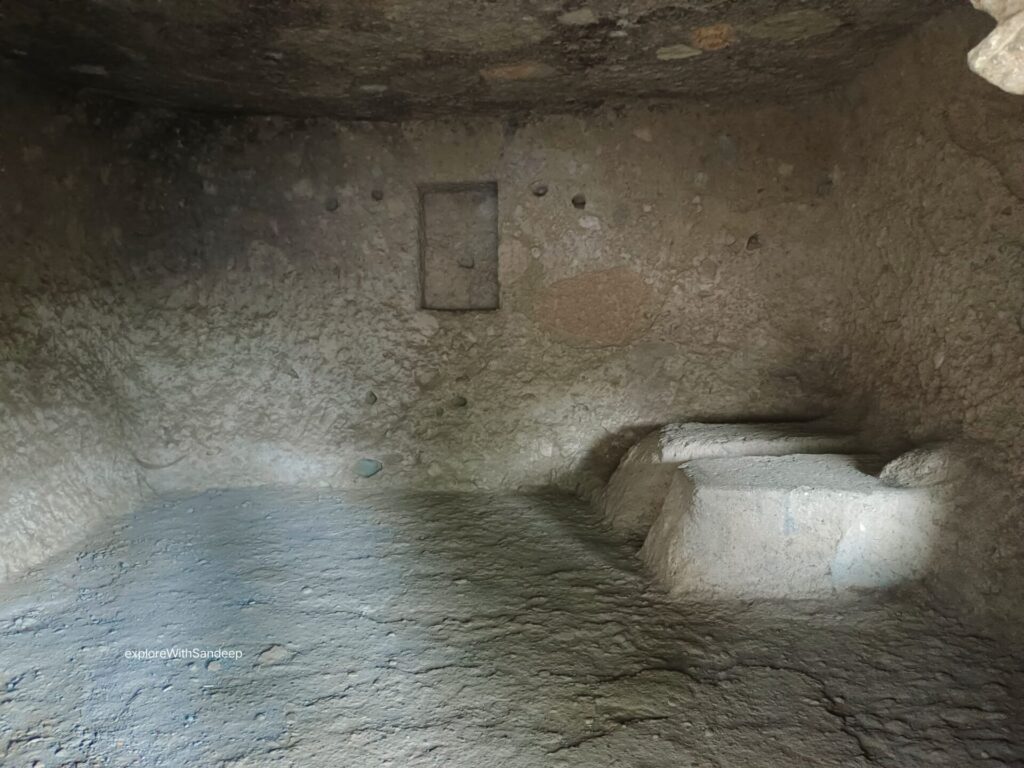

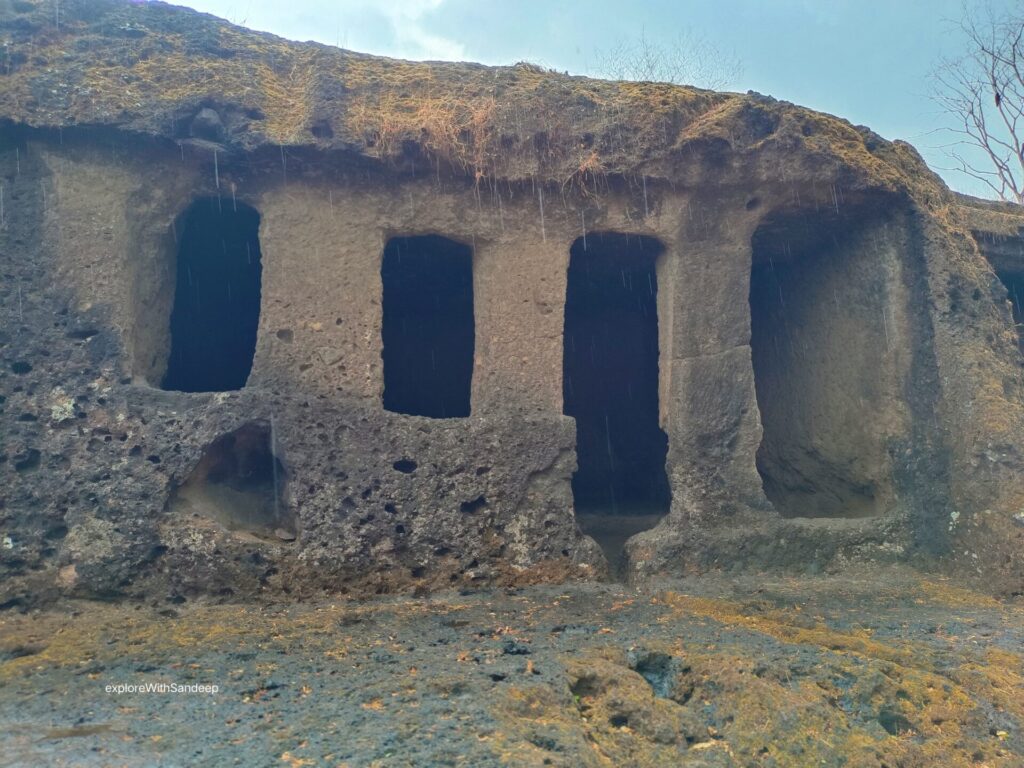
I paused here and imagined what it must have been like: monks sitting cross-legged, sharing simple food, all in complete silence — such a peaceful, disciplined way of life.
Cave 18 (Shiva Temple Cave):
Cave 18 was fascinating because it started as a Buddhist cave but was later converted into a Shiva temple. Although the linga (symbol of Shiva) has been removed now, you can still see the signs of this transformation in the niches and carvings. Standing inside, I reflected on how these ancient spaces have seen centuries of religious change, adapting from one faith to another.
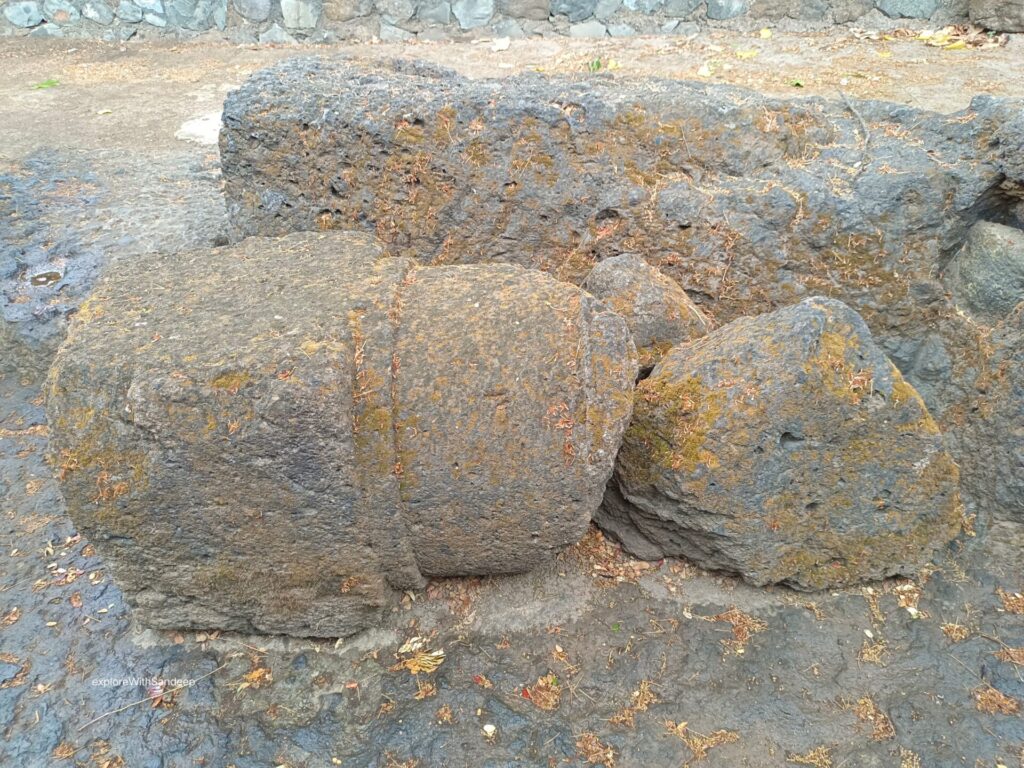

Cave 19 (Large Verandah Cave):
Finally, I arrived at Cave 19, one of the largest caves in the entire Mahakali complex. It had a spacious verandah, stone benches, and carved niches for idols.

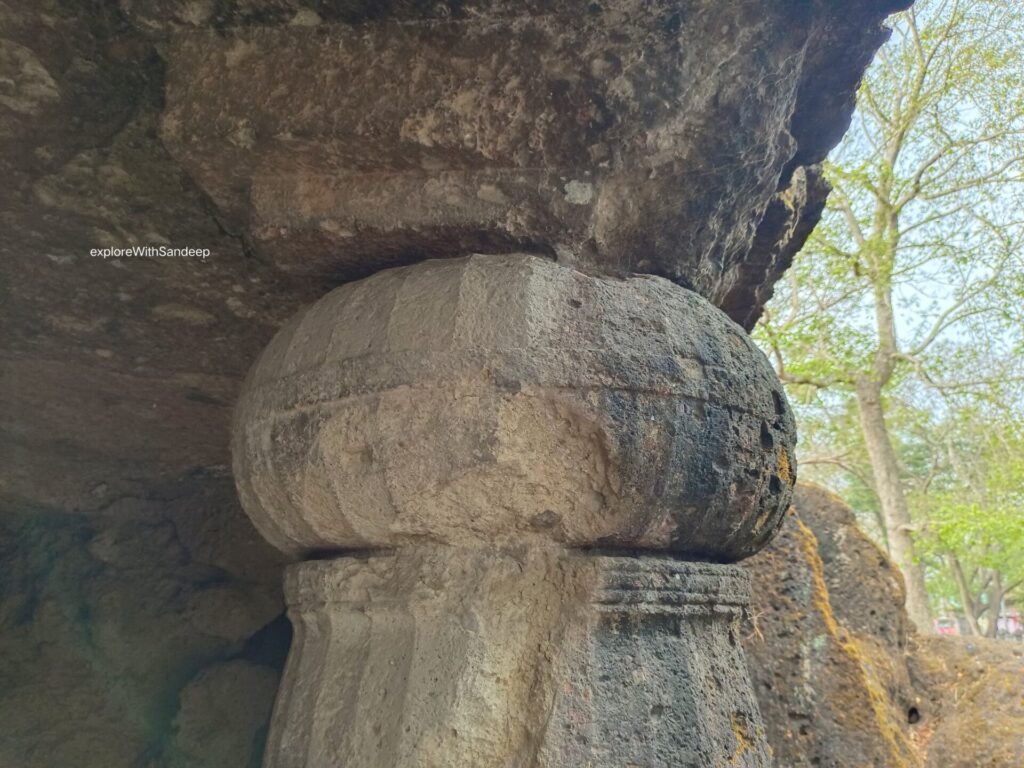


Sadly, I learned that parts of the cave have been damaged over time — not just by nature, but also by modern misuse, like illegal liquor brewing. Still, standing inside this huge, echoing space, I felt both a sense of wonder and sadness: wonder at the skill and vision of the ancient artisans, and sadness at how such heritage sometimes gets neglected.
The Best Part: The Top View!
We climbed the stairs to the top of the caves and – wow! – the view was incredible. With the Mumbai skyline in the distance, the cloudy skies, and light rain, the entire scene looked straight out of a painting.

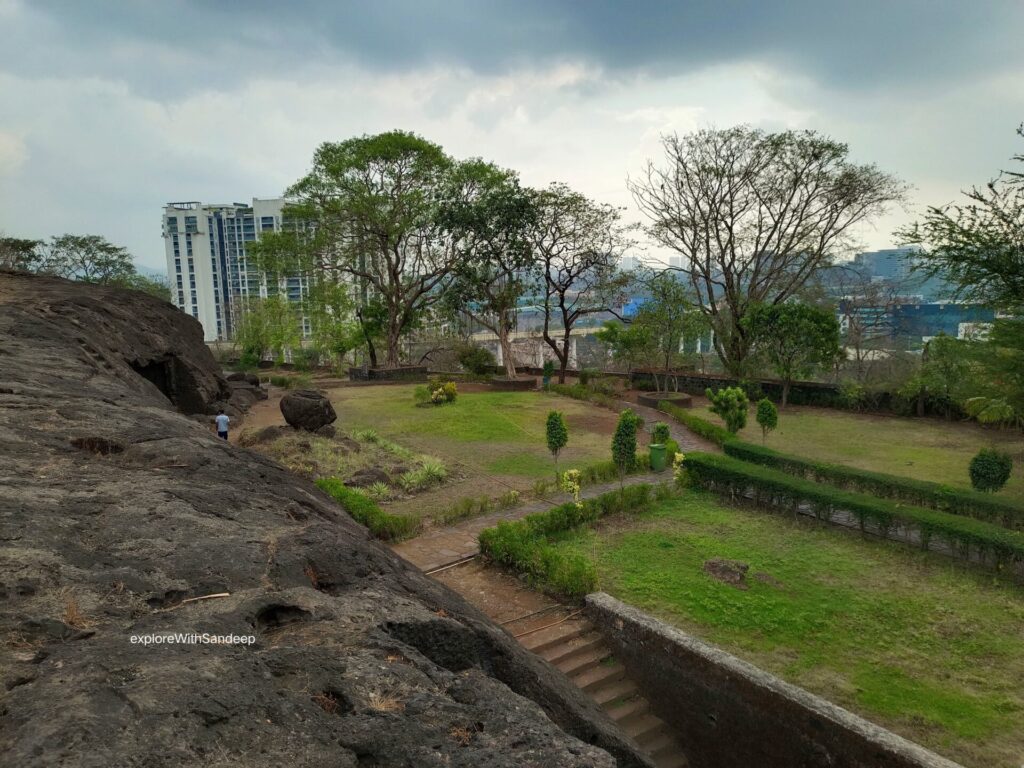



Interestingly, even on top, there are rock-cut water tanks, probably made so that people wouldn’t need to go all the way down for water. Smart, right? Ancient engineers truly knew their stuff!
After soaking in the beauty and clicking lots of pictures, we began our return journey, feeling happy, satisfied, and a little more connected to Mumbai’s ancient past.
Final Thoughts
Visiting Mahakali Caves was not just about looking at old rocks – it was about feeling the history, imagining ancient monks walking through the halls, admiring the craftsmanship of artisans, and reflecting on the passage of time.
If you’re someone who loves exploring offbeat, historical places, this is a gem you shouldn’t miss. You don’t need a full day – even a 2–3 hour visit is enough to experience the magic.
Some tips if you’re planning to visit:
✅ Go early in the morning to avoid crowds and enjoy the cool weather.
✅ Wear good shoes – there’s a bit of walking and climbing.
✅ Carry water and snacks (but don’t litter!).
✅ Keep your expectations realistic – it’s a historical site, not a touristy amusement park.
For me, this trip was not just another weekend outing. It reminded me that Mumbai is full of stories, hidden corners, and surprises – you just have to look.
So, what are you waiting for? Add Mahakali Caves to your Mumbai bucket list, take in the wonder of the past, and maybe even strike a meditation pose for that perfect Instagram shot! 😉
If you’re loving this blog, please drop a comment below and suggest more hidden gems I should explore.
Until the next adventure – keep the spirit of adventure alive! 🌿✈️
How to Reach Mahakali Caves
- By Train: Take a train on the Western Line and get down at Andheri Station. From there, you can hire an auto or take a bus to Mahakali Caves Road.
- By Metro: Take the Mumbai Metro Line 1 (Ghatkopar to Versova) and get off at Western Express Highway or Chakala (J.B. Nagar) station. Then take an auto or taxi to the caves.
- By Road: If you’re driving or on a bike, set your Google Maps to Mahakali Caves, Andheri East. Remember, parking is limited, so come early!
- By Bus: Local BEST buses also run on Mahakali Caves Road – check the local bus routes that stop near the caves.
Nearby Places to Visit from Mahakali Caves
- Jogeshwari Caves (3.1 km, ~15-min auto ride): These ancient rock-cut caves, dedicated to Goddess Jogeshwari and Lord Shiva, date back to 520–550 CE. Their intricate pillar carvings and historical significance make them a must-visit for cave enthusiasts.
- Powai Lake (6 km, ~20-min drive): A serene spot for a post-cave unwind, this lake is surrounded by gardens and walking paths. It’s perfect for a quiet stroll or a quick picnic with a view.
- Aarey Milk Colony (7 km, ~25-min drive): This green oasis offers a peaceful retreat with picnic spots and a glimpse of rural Mumbai. Chhota Kashmir, a garden with a boating lake, is a highlight for families.
- Kanheri Caves (12 km, ~30-min drive): Located in Sanjay Gandhi National Park, these 109 Buddhist caves are older and larger than Mahakali, with stunning paintings and sculptures. It’s a great follow-up for history buffs.
- Lokhandwala Complex Market (4 km, ~15-min auto ride): For a dose of modern Mumbai, this bustling market in Andheri West offers shopping, street food, and vibrant energy. I grabbed some vada pav here to refuel
Mahakali Caves - Frequently Asked Questions (FAQs
1. What are the Mahakali Caves?
The Mahakali Caves, also known as Kondivite Caves, are a group of 19 rock-cut Buddhist caves in Andheri East, Mumbai, dating from the 1st century BCE to 6th century CE. They include viharas (monastic cells), a chaitya (prayer hall), and stupas, showcasing ancient Indian rock-cut architecture.
2. Where are the Mahakali Caves located?
They are situated on Mahakali Caves Road, Andheri East, Mumbai, near the Jogeshwari-Vikhroli Link Road and SEEPZ, perched on a hill overlooking the city.
3. How can I reach the Mahakali Caves?
– By Train: Get off at Andheri (5 km) or Jogeshwari (3 km) station on the Western Line, then take an auto-rickshaw or taxi.
– By Metro: Use Line 1 and alight at Aarey JVLR (0.91 km) or Chakala JB Nagar (2.09 km), followed by an auto or taxi.
– By Bus: BEST buses (e.g., routes 333, 410) stop near Mahakali Caves Road.
– By Road: Drive or ride to the caves; parking is limited, so arrive early.
4. What are the opening hours and entry fee?
The caves are open daily from 9:00 AM to 5:00 PM. The entry fee is INR 20 per person, payable via a QR code for a digital ticket (cash not accepted).
5. What is the historical significance of the Mahakali Caves?
Carved by Buddhist monks, these caves served as a monastery with meditation cells, a prayer hall (Cave 9), and living quarters. They reflect early Buddhist architecture and contain Pali and Brahmi inscriptions, with Cave 9 considered one of Western India’s earliest chaitya caves.
6. What can I expect to see inside the caves?
You’ll find rock-cut viharas, a chaitya with a stupa (Cave 9), meditation cells, octagonal pillars, water tanks, and weathered carvings, including a seven-hooded cobra and amalaka patterns. Some caves show signs of later Hindu use, like Cave 18, repurposed as a Shiva temple.
7. Are the caves well-maintained?
Yes, the Archaeological Survey of India (ASI) maintains the site, keeping it clean and fenced to prevent encroachment. However, the soft volcanic breccia rock has led to weathering, and some carvings are faded or damaged.
8. What should I bring or prepare for a visit?
– Wear comfortable shoes for walking and climbing.
– Carry water and snacks, as amenities are limited.
– Visit early in the morning for cooler weather and fewer crowds.
– Avoid littering to preserve the site.
9. Are there any nearby attractions to explore?
Yes, you can visit:
– Jogeshwari Caves (3.1 km): Ancient rock-cut caves with Shiva and Jogeshwari carvings.
– Powai Lake (6 km): A serene spot for relaxation.
– Aarey Milk Colony (7 km): A green retreat with picnic spots.
– Kanheri Caves (12 km): Larger Buddhist caves in Sanjay Gandhi National Park.
– Lokhandwala Complex Market (4 km): A vibrant market for shopping and food.
10. Is photography allowed, and are the caves crowded?
Photography is permitted for personal use (commercial shoots may need ASI approval). The caves are less crowded than other sites like Kanheri, making them ideal for a peaceful visit, especially for history and architecture enthusiasts.

